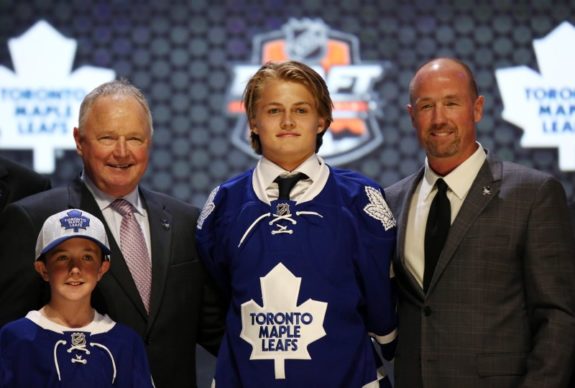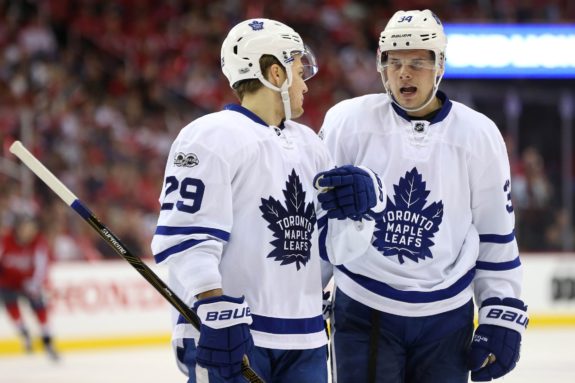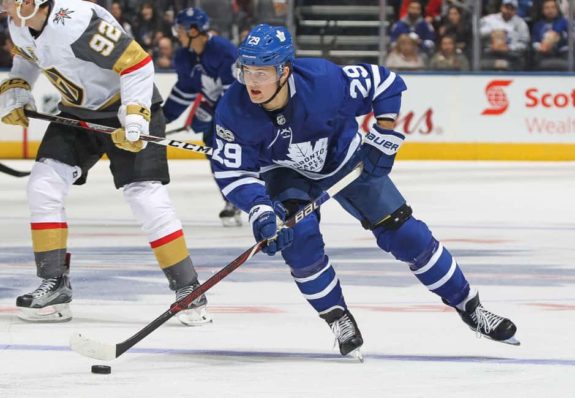One would expect the top priority in the coming weeks for the Toronto Maple Leafs to be finalising an extension for one of their top young talents, William Nylander.
Not only is the offensive dynamo in need of a new contract, the Maple Leafs are no doubt eager to get a deal done before Jul. 1, given the fact Nylander will be eligible – and therefore the Leafs at risk – for an offer sheet.
This contract negotiation is of especial importance, given that the current, entry-level deals of Toronto’s other two star forwards, Auston Matthews and Mitch Marner expire at the end of next season. Both the term and the annual compensation of Nylander’s new contract will undoubtedly be used as measuring sticks in the re-singing of his fellow stars.
Undeniably talented, Nylander has tallied 42 goals and 122 points over the last two seasons, and is very clearly capable of even more.
With talent and on-ice performance therefore taking a back seat, there should only be one bone of contention – especially given the premium placed on the position – sure to dominate discussions:
Is William Nylander a centre?
Can Nylander Play Centre?
Depending on your source, Nylander was originally drafted as a centre. Or a right-winger. Or just a winger. Or some combination thereof. Whatever.

Keep in mind this is the same league that denied Taylor Hall a major award because people couldn’t decide if Alex Ovechkin played left or right wing, so I suppose we shouldn’t really be that surprised.
But I digress.
Regardless of what he was technically drafted as, it’s reasonable to say Nylander had at least some experience at the centre-ice position prior to playing his first game in the National Hockey League.
However, since debuting with the Maple Leafs on a full-time basis in 2016-17, Nylander has spent most of his time playing the wing, most often on a line with Matthews and Zach Hyman, or else one featuring Leo Komarov and Nazem Kadri.
That said, he’s filled in at times up the middle, such as this past season when Matthews missed time due to injury.
Maple Leafs Want Versatile Forwards
Of course, he wasn’t the only one shuffling between positions. For instance, Patrick Marleau played centre for a short stretch, and was no stranger to draws in general, taking 301 faceoffs over the course of the season. Likewise, Komarov wasn’t an uncommon sight at the dot, taking 212 draws of his own.
In fact, the Maple Leafs distributed their draws over more players than nearly any other team in the NHL, with 10 Toronto players taking at least 152 faceoffs in 2017-18.

Nylander, for his part, ranked fourth on the team with 650 draws to his name. To unpack that a bit, Tyler Bozak, Kadri and Matthews, in that order, were the only players with more faceoffs than Nylander, which makes sense, considering they’re the team’s top three centres. Ordinarily, one would expect to see the Maple Leafs’ fourth-line centre in there, as well, but said position has been in flux on the Leafs since time immemorial.
The point is, Nylander takes a hell of a lot of draws for someone that’s not explicitly a centre. He’s reasonably good at them, too, with a 51.4 percent success rate in 2017-18, up from 40.2% the year previous, when he, not surprisingly, took only 122.
Clearly, the Maple Leafs see value in versatile forwards. First and foremost, having multiple centres on a line, particularly at least one shooting each way, ensures the team never has to have a centreman take a draw on his weak side. Additionally, should the NHL’s admirable crackdown on faceoff violations continue, an extra pivot can mitigate the effects of the primary centre being tossed from the circle. Furthermore, having the ability to slot players in multiple positions covers the Leafs, should a new face – whether signed, traded-for or called-up – not work out in a given role.
The bottom line? The Maple Leafs need Nylander to play centre, even if they don’t need him to play centre.
Should Nylander Play Centre?
Along with his résumé up until this point, Nylander’s contract negotiations will no doubt also be focussed on what’s to come for the 22-year-old. Nylander has played centre on occasion for the Maple Leafs. Thus, the question now becomes, should he be playing centre, both now and for the foreseeable future?
How Has Nylander Performed at Centre?
Small sample size or not, Nylander has played enough at centre to give people an idea of his suitability for the position. For a game-by-game analysis of Nylander’s play as a pivot, Pension Plan Puppets had an excellent write-up back in March. As for the organisation’s perspective, here’s head coach Mike Babcock giving his thoughts back in December:
Anyone who’s followed the Maple Leafs the past couple seasons doesn’t need the coach to tell them the exigency isn’t always present in Nylander’s game, particularly on defense. He undoubtedly possesses both the physical ability and mental acuity to dominate in the NHL – and he often does, periodically turning things up to 11, seemingly at will. However, this doesn’t change the fact he sometimes leaves people wanting more.
The general takeaway is that Nylander’s centre game needs some work, more so in the realms of consistency and intensity, rather than skillsets and fundamentals. Of course, his sample size is still relatively small, but, given that his contract has to get done before the fall – before Jul. 1 if new general manager Kyle Dubas is worth his salt, there’s not a whole lot else to go on.
Maple Leafs’ Lineup Options
On the one hand, Nylander – at this stage of his career, anyway – seems a little better suited to the wing at the NHL level. On the other, the Maple Leafs should be wary of turning him into Alex Galchenyuk. For the uninitiated, the Montréal Canadiens have refused to allow Galchenyuk to develop properly as a centre, and then justified their decision to keep him on the wing by complaining he hasn’t developed properly as a centre (despite ample evidence to the contrary).
Therefore, if we assume Matthews continues to centre the Maple Leafs’ first line, and the trio of Kadri, Marleau and Marner remains together (as together as a line can be on a Babcock-coached team), there are three viable options for Nylander:
Nylander as a First-Line Winger
This option would see Nylander sticking where he’s been the most, skating alongside Hyman and Matthews on Toronto’s top trio. Such a setup would guarantee the Maple Leafs a dominant first line for years to come, while masking Nylander’s occasional deficiencies by playing him with two of the hardest-working, most defensively aware players on the team.

However, such a setup would concentrate Toronto’s offense in their top two lines, particularly now that third-liners Bozak and James van Riemsdyk are unrestricted free agents and unlikely to be back in a Maple Leafs uniform come the fall.
Nylander as the Third-Line Centre
The Maple Leafs could certainly do worse than making Nylander the pivot on the third line, sheltering him from the top scorers of the opposition while he continues to develop at the centre-ice position.
Unfortunately, it might also mean stagnation, if not a dip, in Nylander’s production, due to him likely having to play alongside less-established wingers than those the third line featured this past year.
Nylander as a Third-Line Winger
Playing Nylander at wing on the third line would further insulate him from the requirements of playing centre. All the Maple Leafs would have to do is insert an offensively competent, defensively responsible centre to skate alongside him, and he should be set up for success.
Of course, such players are few and far between, especially at the price Toronto can afford to pay. The Maple Leafs probably aren’t going to get someone as good as Bozak to fill that role (unless they’re able to re-sign him, a prospect heavily dependent on price), though there will be some interesting options out there.
Again though, such a setup might depress Nylander’s production.
Is Too Much Balance a Bad Thing for Maple Leafs?
Given the premium placed on centres, my suggestion would be to put him at centre on the third line. He’s got elite talent, so all the Maple Leafs would have to do is find some cheap, serviceable wingers willing to adapt their game to his – à la the Pittsburgh Penguins, and they should have three pretty terrifying lines.

On the other hand, the Maple Leafs, of all teams, don’t need to score by committee. Separating the stars risks diluting the team’s talent.
Plus, in having three big lines, Toronto would also risk not playing their top players enough. The Maple Leafs had enough problems with that this season, even though Nylander most often played on the first line. Matthews, unquestionably Toronto’s best player, averaged a paltry 18:08 of ice time. Though first amongst Leaf forwards (Nylander was fifth, at 16:41), Matthews ranked an astounding 71st amongst NHL forwards, just ahead of Tomas Hertl, and behind the likes of Alexander Wennberg and Nick Schmaltz.
Thus, the Maple Leafs, in considering Nylander’s suitability for centre, also have to consider how best to maximise the talent they have (i.e. ensuring their elite talent receives the necessary ice time to optimally ply their trade), while ensuring as balanced a lineup as possible.
A tricky situation, to be sure.
Where Will Nylander Fit on the Maple Leafs?
So, is Nylander a centre? With solid arguments on each side – both backed by solid evidence, there’s no clear answer.
Arguments aside, the simple fact of the matter is, centremen make more money.
Nylander’s camp can make a pretty good case the Maple Leafs have already been using him as a centre on a semi-regular basis. They can also argue that, given the probable departure of Bozak, they’ll likely be using him up in the middle full time in the very near future.
On the Maple Leafs’ side, they can point to the fact that, when fully healthy, the lineup doesn’t need Nylander as a centre, outside of some specific situations and to provide extra depth at the position.
Whatever the agreement reached by the two sides, Nylander’s contract will not only set a baseline for those of Marner and Matthews, it might also determine the future trajectory of his career.
Whoever said the offseason is relaxing?
(All line combination information is thanks to Corsica and is at five-on-five, unless otherwise specified.)